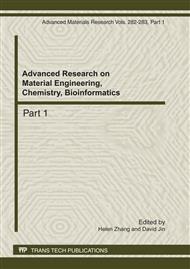[1]
Chaum, D. Blind signatures for untraceable payments. In Advances in Cryptology: Proceedings of Crypto'82. Prenum Publishing Corporation, New York. (1982), p.199–204.
DOI: 10.1007/978-1-4757-0602-4_18
Google Scholar
[2]
Abe, M., and E. Fujisaki. How to date blind signatures. In Advances in Cryptology: ASIACRYPT'96, Lecture Notes in Computer Science, vol. 1163. Springer-Verlag, Berlin (1996), p.244–251.
DOI: 10.1007/bfb0034851
Google Scholar
[3]
Abe, M., and T. Okamoto. Provably secure partially blind signatures. In Advances in Cryptology: CRYPTO2000, Lecture Notes in Computer Science, vol. 1880. Springer-Verlag, Berlin (2000), p.271–286.
DOI: 10.1007/3-540-44598-6_17
Google Scholar
[4]
Q. Wu, W. Susilo, Y. Mu et al. Efficient partially blind signature scheme with provable security. ICCSA 2006, LNCS 3982, Springer-Verlag, Berlin (2006), pp.345-354.
DOI: 10.1007/11751595_38
Google Scholar
[5]
X. Chen, F. Zhang and S. Liu. ID-based restrictive partially blind signatures. Journal of System and Software, 80(2): (2007). pp.164-171.
DOI: 10.1016/j.jss.2006.02.046
Google Scholar
[6]
C. Wang, Y. Tang and Q. Li. ID-baseed fair off-line electronic cash system with multiple banks. Journal of Computer Science and Technology, 22(3) (2007), pp.487-493.
DOI: 10.1007/s11390-007-9055-1
Google Scholar
[7]
Chaum, D. Designated confirmer signatures. In Advances in Cryptology: EUROCYPT'94, Lecture Notes in Computer Science, vol. 950. Springer-Verlag, Berlin (1994), p.86–91.
DOI: 10.1007/bfb0053427
Google Scholar
[8]
D. Wikström. Designated confirmer signatures revisited. TCC 2007, Lecture Notes in Computer Science, vol. 4392, Springer-Verlag, Berlin (2007), pp.342-361.
DOI: 10.1007/978-3-540-70936-7_19
Google Scholar
[9]
F. Zhang, X. Chen and B. Wei. Efficient designated confirmer signature from bilinear pairings. ASIACCS'08, ACM, (2008), pp.363-368.
DOI: 10.1145/1368310.1368363
Google Scholar
[10]
L. El Aimani, On generic constructions of designated confirmer signatures. Progress in Cryptology: INDOCRYPT 2009, Lecture Notes in Computer Science, vol. 5922, Springer-Verlag, Berlin (2009), pp.343-362.
DOI: 10.1007/978-3-642-10628-6_23
Google Scholar
[11]
L. El Aimani, Toward a generic construction of convertible undeniable signatures from pairing-based signatures, Cryptology ePrint Archive, Report 2009/362, 2009, http: /eprint. iacr. org.
DOI: 10.1007/978-3-540-89754-5_12
Google Scholar
[12]
L. T. Phong, K. Kurosawa, and W. Ogata. New RSA-based (selectively) convertible undeniable signature schemes. In AFRICACRYPT09, Lecture Notes in Computer Science, Vol. 5580, Springer-Verlag, Berlin (2009), p.116–134.
DOI: 10.1007/978-3-642-02384-2_8
Google Scholar
[13]
Z. Huang, K. Chen and Y. Wang. Provably secure convertible user designating confirmer partially blind signatures. Informatica, Vol. 17, No. 3, (2006). pp.347-362.
DOI: 10.15388/informatica.2006.142
Google Scholar
[14]
Feige, U., A. Fiat and A. Shamir . Zero-knowledge proofs of identity. Journal of Cryptology, 1, (1988), p.77–94.
DOI: 10.1007/bf02351717
Google Scholar
[15]
C. P. Schnorr. Efficient signature generation by smart cards. J. Cryptology, 4 (1991), pp.: 161-174.
DOI: 10.1007/bf00196725
Google Scholar


